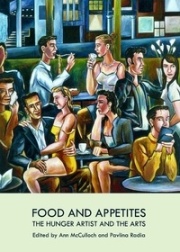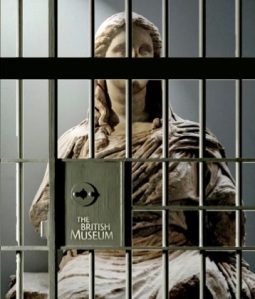
For a moment my mouth watered at the thought of eating a piece marble cake. I imagined a wonderfully tasty delight – pentellic undulations narratively encircling an iconic Greek cake, nourishing my humanity and my fantasies. However, a close look at the recipe provided by
O’Really, meant that I had to: “travel to Greece, find a beautiful cake, vandalise the tastiest parts, proclaim ambassadorial privilege, then return with my souvenir cakes.” O’Really and some of his respondents even have some serving suggestions: a sea salt curing method, a basement storage tip, and a way to remove the crust and freshen them up for presentation.
What’s going on? I just want to eat cake and have my conscience too. If so, then we need to dismantle the ideological writings of the British Museum (BM) on the Parthenon Sculptures, as found on their website here. (Thanks to the Elginism website for the tweet sharing the above ‘recipe’, and for the continued research and voice into this issue.)
Starting at the top of the BM webpage: “What is the Parthenon and how did the sculptures come to London.” The Parthenon indeed has a long history, but contrary to what is stated, it is not “complex”. It is rather straight forward. The building has been subject to many ravishes that can be sequentially itemised, laying out a history both clearly and simple. (Attempting to describe that history as “complex” is a way to pollute and scandalise it as a ‘difficult problem’.) In fact, a simple exposition is then what proceeds for the remainder of the two paragraphs; an exposition whose facts are as erroneous as they are trivialised; whose flaws I cannot bring myself to enunciate here, given this has been eloquently achieved by many others, such as Christopher Hitchens here.
What I want to do, is examine the ensuing sections on the BM webpage, starting with, “Where can the surviving sculptures from the Parthenon be seen?” The remarks made in this section contain all the ingredients for the ideological apologia that it is; using language as the obfuscating tool it can be, then, letting rip with the force of gunboat diplomacy. Is there an urge here that seeks to hide the BM’s complicity in the retention of plunder?
Firstly, and it’s all about context now; the BM describes the sculptures as “surviving”, (read: poor, wayward, unable to look after themselves fragments), that are “equally divided between Athens and London,” (trying to bring a sense of acceptable ‘balance’ in that distribution),…”While important pieces are also held in the Louvre and Vatican,” (reputable institutions like these, also parentally overseeing these vagabond sculptures).
Next we have, “Parthenon Sculptures in Athens.” It tells us that the Greek authorities have been “removing the sculptures,” (to place inside the Parthenon Museum). The notion here is that the Greeks themselves are also vandalising the building, (‘just like we have, so they are no better than us’),…”work that was begun over 200 years ago by Elgin.” Indeed. Equating the modern Greek acts with the acts of Elgin is nothing short of scandalous. The BM continues.
“Parthenon Sculptures in London.” “Sometimes known as the Elgin Marbles”, (only by the BM and its supporters, everyone else uses the respectful and obviously rightful term of the “Parthenon Marbles”)….”have been on display since 1817” (‘behold the public service we’ve been providing to the Empire and the world), …”and..(the real kicker)…..”for free.” (‘To charge would be inappropriate, and our concern for the public at large is paramount – our morals remain intact.) The following argument of “seen by a world audience” is simply refuted by the idea that, if we want as many people as possible to see the Marbles, then let’s put them in Disneyland. I won’t dwell on the BM’s “research” into discoveries of ancient applied colours; is this research a result of removing (scrubbing off) layers of marble from the sculptures in the 1930s?
“Parthenon Sculptures in other Museums.” A list of museums follows, somehow justifying the BM’s retention, as well as diverting attention to the legitimacy of the other institutions acquisitions, and promoting the idea of a necessary parental ‘custodial role’.
“What has the Greek Government asked for?” Here it states that “Since the 1980, (only as recently as that? what a weak claim!), Greek Governments have argued for their permanent removal,” (read: abducting these children from the bosom of the BM.) Absolutely nothing about ‘returning them to their rightful home,’ illegally taken or not)… of “all the Parthenon Sculptures in the BM.” (The important word here is “all.” What, and leave nothing in the BM? ‘But we’ve grown fond of them here’.) Then we come to another kicker: “The Greek government has also disputed the British Museum Trustees’ legal title to the sculptures.” (Fancy that, disputing the upright imperial legality of the ‘title’ that the BM ‘claims’ to have.) Continuing on, they give us the most generic hyperlink, to the homepage of the ‘Greek Ministry of Education and Religious Affairs, Culture and Sports.’ No direct link to the opposing arguments, presumably hopeful that we might get bored in having to research the appropriate section outlining the Greek government’s position. A thinly veiled attempt at claiming some moral high ground by providing ‘balance’.
“What is the British Museum’s position?” Following here is the argument for the ‘Universal Museum.’ This argument basically posits that, (the BM as the definitive example), antiquity belongs to all humanity, and cultural artifacts belong in big encyclopedic museums. As James Cuno, CEO of the J. Paul Getty Trust states, we need a place that promises(?) to, “promote tolerance and understanding difference in the world,…that is against essentialised national differences.” Read more here and here. Neil MacGregor, director of the British Museum, has become the most vocal proponent of this position, adding that we can have “all the world’s cultures under one roof”, in a “secular cosmopolitan space.” The encyclopedic museum “enlarges one’s view of the world.”
As Tom Flynn argues in, “The Universal Museum: A valid model for the 21st century?”, such institutions trace their “historical roots in the Cabinets of Curiosity assembled by European princes from the fifteenth to the seventeenth centuries. The early ‘universal’ cabinet collections ultimately formed the foundations of the great western ‘encyclopedic’ museums which in turn benefited from the era of colonialism and imperial adventure in the nineteenth century.”
Flynn continues, “the concept of a ‘universal museum’ is philosophically and practically flawed, an anachronistic aspiration that is the product of an idealistic, eighteenth-century Enlightenment mindset devoted to the accumulation and classification of all species of flora and fauna, natural and man-made objects. Such collections are not only unsustainable but perpetuate many of the worst aspects of the age of imperialism.The fact is that Universal Museums are self appointed. No other countries have asked them to look after their cultural treasures – and then refuse to return them later. As such, they have no moral right to hang on to the huge numbers of items that were acquired in very dubious circumstances, carefully omitted from the labels on the artefacts today”
Flynn even identifies the “therapeutic function” of such museums, taking on a ‘healing’ role, in the face of ‘resurgent nationalism and sectarian violence,’ that might damage these works; acquisition as benevolence, retention as remedy.
Later, on the same BM webpage, we read of the “acceptance” by the BM of the sculptures in the Athens Parthenon Museum as being part of a “backdrop of ancient Greek and Athenian history.” This primes us for a claim that the Marbles in London are an “important representation of ancient Athenian civilization in the context of world history.” Oh dear. Let’s leave to one side the aspect of ‘representation’; this idea means that the Marbles in Athens are only part of a “local” history and culture, (placed in their local museum setting), while claiming the very fact of their importance in “world history” that is is only possible in London!
We are than asked to accept the BM Trustees’ “conviction” that the “current division” (between Athens and London) allows for “different and complimentary stories to be told.” (These are false dichotomies, creating the very divisions they seek to eliminate, that allow the manufacture of ‘competing’ stories. Stories from whose perspective? It might be acceptable if the BM told stories are of dubious firmans, of grotesque hacking at marbles, of sunken loot, of selling to the BM, etc, but instead we get stories of ‘stewardship’. Surely not stories from the Parthenon Frieze itself, whose very narrative is fractured, and unable to be ‘read’ in toto, and in situ. So that the only way to affirm, (and here comes the patronizing attempt at being magnanimous)…”the place of Ancient Greece among the great world cultures,” is to fetishize it from afar.
Lastly, a plea to the visitors of the British Museum, especially in this Olympic year – that if you have cake, probably at the BM Café, just maybe, you are eating it too. Imagine the day, when we can share a piece of cake, in front of the oven that baked it, with the children of the cooks, and marvel at how tasty and sustaining these morsels are.
(originally published Wednesday, 11 July 2012)










